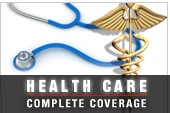As you may have heard, health-care spending has taken a somewhat encouraging turn over the last few years. A combination of a recession "hangover," implementation of the Affordable Care Act Medicare payment reforms and patients spending less out of pocket have kept prices in check. Both Medicaid and Medicare, for example, spent 5 percent less last year than their 2010 projections.

The question perplexing health-care economists at the moment is whether medical spending will continue to moderate or once again start to outpace inflation. Although lower spending for the public programs is a good short-term trend, it's uncertain if the 3 percent annual health-spending growth rate from 2009 through 2011 will continue. The verdict on the Affordable Care Act is long from decided and Americans may decide to opt for more medical care if the economy continues to rebound.
For the moment, though, there are several positive signs that health costs are ramping down from average 6-percent growth recorded in the previous decade. A recent report by PwC, an international consultant and auditor, forecasts that medical inflation is projected to drop in 2014. The PwC report outlines some reasons for optimism:
"Individual consumers, bearing more financial responsibility for their medical bills, are questioning and sometimes delaying procedures, imaging, and elective services. New delivery models, such as accountable care organizations (ACOs) are promising, but their prospects for significant savings remain largely unproven. The ACA will also play a role in the slowdown in 2014, with hospitals working to hold down expensive readmissions (or face the law’s penalties) and employers being given greater power to influence employee behavior through increased or discounted premiums — up to 50 percent in some cases."
What's behind the cost slowdown? A comprehensive effort to hold down expenses in the private and public sector.
Medicare, for example, is penalizing hospitals for high readmissions rates. More health-care organizations are changing their business models to incorporate "coordinated care," which puts all specialists and other providers on one page to reduce costs and improve quality of care.
RELATED: MEDICARE PLANS TO GRADE HOSPITALS WITH STARS
Employers have jumped on board the cost-savings wagon with more aggressive chronic care and wellness programs. Some companies are even negotiating steep discounts on common procedures with providers. Here are some other notable cost-savings trends:
- Care is increasingly being provided in non-traditional settings. Major pharmacy chains and discount stores such as Walgreens, CVS and Target have in-store clinics. These "doc in a box" facilities offer basic care at lower prices.
- Employers are offering more high-deductible plans. In an effort to lower premiums, higher out-of-pocket costs make patients more aware of what they're spending. Some 17 percent of employers surveyed by PwC now offer the plans and more than 44 percent are considering them.
- Companies are also experimenting with incentives. Some employees may qualify for lower out-of-pocket costs if they enroll in chronic-care or wellness programs. Those who make an effort to take care of themselves may see lower premiums.
FLIES IN THE OINTMENT
Not every observer is sanguine about the decline in health-care spending. Politics have intervened in a number of pronounced ways to prevent further progress.
Take the idea of applying the same discounts provided on prescription drugs for Medicaid patients to Medicare recipients. Medicare would save some $134 billion from 2014 through 2023, according to the Congressional Budget Office. That's the power of applying a "single-buyer" model to the drug purchasing. Medicare, however, employs a reverse approach where no discounts are mandated and drug companies are paid to participate in its "Part D" program.
Naturally, drug companies grimace at the idea of extensive discounting. So drug prices may not follow the script of flattening costs. It's highly unlikely that the Part D program will be changed any time soon by Congress to make it more competitive.
Also bucking the top-down, cost-control trend are hospitals and other providers, which have been consolidating in several states in recent years. According to the PwC report, industry consolidation has increased more than 50 percent since 2009.
Greater market control reduces competition, which means that providers can charge higher prices. The consultants’ report found price increases of 20 percent in markets where hospital consolidation occurred. Hospital groups that dominate metropolitan areas or states benefit from their concentration of services. They feel less pressure to lower their prices.
Another cost driver is the introduction of new drugs and treatments. They tend to be expensive, yet Americans are used to the latest and best ways to treat a variety of maladies.
The hardest political medicine to swallow -- both in private and public programs -- is increased cost sharing. The Obama Administration, for example, has proposed higher deductibles and premiums for affluent Medicare beneficiaries.
Employers also are charging more for insurance: premiums for family coverage rose 4 percent in 2012 over the previous year, according to the Kaiser Family Foundation.
Transparency is a major game-changer in overall health spending. Most employer-covered Americans have no idea what they or their employer spends on health care. Unless patients have to pay much more out of pocket for their care, they will expect their insurance to cover higher-cost care and won't have a stake in reducing spending. Shedding light on actual costs may accelerate the overall move to reduce spending. Sunlight has proven to be the best disinfectant.






